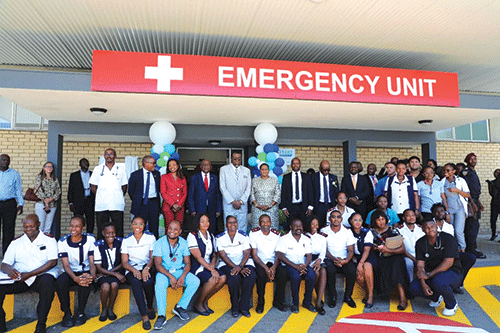The health ministry is faring well with its mandate, making good strides in improving the quality of health services through investments in training health workers, procuring equipment, and ensuring the availability of medicines. Some notable achievements and programme outputs completed during the 2020 to 2023 budget cycle are:
Quality network infrastructure
These internet network structures were installed in all 35 district hospitals across the country, allowing for the implementation of the ministry’s eHealth strategy, including the delivery of medicine to harness the power of information communication technology.
Multi-hazard Preparedness and Response Plan
Despite strengthening preparedness and response to health-related and non-health-related hazards, the ministry, together with the Office of the Prime Minister and ministries of agriculture, environment and other stakeholders, finalised a multi-hazard Preparedness and Response Plan. The plan identifies Ebola, Covid-19, Crimean Congo haemorrhagic fever, Marburg virus disease, cholera, novel influenza, road traffic accidents, floods, wildfires, rabies, bacterial meningitis, radioactive materials and earthquakes as hazards which our country must be prepared for.
Equipment
The ministry has further purchased a variety of medical equipment for health facilities during the period under review. This includes equipment related to maternity care, such as 170 infant incubators, 13 x-ray machines, two Computed Tomography scanners, 28 dialysis machines and 17 dental chairs and paraphernalia.
“The good news specifically for Namibian women is that two mammograms were procured, aligned for the screening and detection of breast cancers at an early stage so that treatment can be initiated,” health minister Kalumbi Shangula was quoted as saying earlier this year.
HIV/AIDS
The ministry should be applauded for measures towards achieving 95-95-95 targets for HIV. In Namibia, 92% of people with HIV know their status, 99% of those who know their status are initiated on treatment and of those on treatment, 94% are virally suppressed. The ministry says nearly 100% of persons receiving antiretroviral therapy have transitioned to the more efficacious dolutegravir regimen. The ministry continues to expand antiretroviral therapy services to prevent mother-to-child transmission, which now stands at 91% coverage.
On 3 March 2023, Namibia received an international recognition award for the remarkable progress towards reaching the UNAIDS 95-95-95 targets and efforts towards ending AIDS as a public health threat by 2023.
Universal Health Coverage
Although universal health coverage (UHC) concentrates disproportionately on issues of cost, there is a need for a robust approach by government in ensuring that no Namibian should be deprived of healthcare services due to finances. The ministry was allocated N$9 684 890 000 for the 2023/2024 financial year.
“Cabinet has approved the UHC Policy Framework, and considerable progress has been made. Attaining UHC would mean that the people of Namibia would have access to affordable, equitable, quality health services without suffering financial hardship,” Shangula was quoted as saying. Shangula said the ministry is committed to attaining UHC for Namibia, and progress has been made thus far.
Health is everyone’s business
Standard Bank and the Motor-Vehicle Accident Fund unveiled the renovated Katutura Intermediate Emergency Care Unit, which was completed at a cost of N$12.6 million.
UNFPA and Japan provide reproductive health commodities to sustain critical sexual and reproductive health needs in Namibia.
The U.S. President’s Emergency Plan for AIDS Relief (PEPFAR) invested approximately N$840 million (US$45 million) in providing health and social services to vulnerable children, adolescents and youth in Namibia.
#BeFree movement under the One Economy Foundation mobilised the youth to talk about mental health. The opening of the #BeFree Youth Campus acts as a psychosocial support centre for those who need counselling.
Challenges crippling the healthcare system
The executive director in the line ministry, Ben Nangombe, has expressed disappointment in the poor services that Namibians visiting public health facilities are at times subjected to. He said if in that moment of vulnerability health workers do not demonstrate the necessary level of compassion, “then we need to go back to the drawing board and address the issues of the conduct of healthcare workers, otherwise we are going to have a policy with beautiful provisions that is not going to have the required impact”.
Furthermore, the public health sector is hampered by shortages of critical staff, including doctors and specialists. With an estimated 0.6 physicians and two nurses per 1 000 people, staff shortages not only impact on the quality of care, but result in costly overtime, feeding into high wage outturn. A review of the key personnel establishment for the health ministry is needed to right-size it in line with the disease burden.
Unicef states that a significant share (28.9%) of the Total Government Health Expenditure is spent on the Public Service Employee Medical Aid Scheme (PSEMAS), whose coverage is 12% of the total population, raising equity concerns.
Nearly 520 000 people in Namibia are suffering from at least one type of mental illness. The country needs to invest more in mental health treatment. Other setbacks included a shortage of medicine and other pharmaceuticals due to procurement-related issues.
The dilapidated state of clinics and hospitals, among others, also made headlines, pointing out a lack of adequate beds and linens, forcing patients to sleep on the floors and in corridors.
– psiririka@nepc.com.na


